 The purpose of the Achilles tendon is to connect the heel bone to the calf muscles and it is considered to be the largest tendon in the body. The ability to point and flex the foot occurs naturally when the Achilles tendon contracts and this also enables people to walk, run, and stand on tiptoe with ease. If the patient should experience a tear in this tendon, this condition is referred to as an Achilles tendon rupture. General reasons for this to occur may include the tendon weakening with age, which may promote injury. It typically occurs when activities that are pursued require running and jumping, also when proper stretching is not practiced beforehand. Typical symptoms may include experiencing an immediate and severe pain in the back of the heel, as well as swelling and bruising. If you feel you have ruptured your Achilles tendon, please consult with a podiatrist to learn about correct treatment techniques.
The purpose of the Achilles tendon is to connect the heel bone to the calf muscles and it is considered to be the largest tendon in the body. The ability to point and flex the foot occurs naturally when the Achilles tendon contracts and this also enables people to walk, run, and stand on tiptoe with ease. If the patient should experience a tear in this tendon, this condition is referred to as an Achilles tendon rupture. General reasons for this to occur may include the tendon weakening with age, which may promote injury. It typically occurs when activities that are pursued require running and jumping, also when proper stretching is not practiced beforehand. Typical symptoms may include experiencing an immediate and severe pain in the back of the heel, as well as swelling and bruising. If you feel you have ruptured your Achilles tendon, please consult with a podiatrist to learn about correct treatment techniques.
Achilles tendon injuries need immediate attention to avoid future complications. If you have any concerns, contact Dr. Barbara Kilkenny of Barbara A. Kilkenny, DPM. Our doctor can provide the care you need to keep you pain-free and on your feet.
What Is the Achilles Tendon?
The Achilles tendon is a tendon that connects the lower leg muscles and calf to the heel of the foot. It is the strongest tendon in the human body and is essential for making movement possible. Because this tendon is such an integral part of the body, any injuries to it can create immense difficulties and should immediately be presented to a doctor.
What Are the symptoms of an Achilles Tendon Injury?
There are various types of injuries that can affect the Achilles tendon. The two most common injuries are Achilles tendinitis and ruptures of the tendon.
Achilles Tendinitis Symptoms
Rupture Symptoms
Treatment and Prevention
Achilles tendon injuries are diagnosed by a thorough physical evaluation, which can include an MRI. Treatment involves rest, physical therapy, and in some cases, surgery. However, various preventative measures can be taken to avoid these injuries, such as:
If you have any questions please feel free to contact our office located in Southbury, CT. We offer the newest diagnostic tools and technology to treat your foot and ankle needs.
Read more about Achilles Tendon Injuries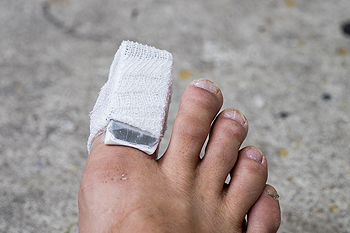 If you have ever experienced a broken toe, you are most likely familiar with the pain and discomfort that is associated with it. Despite the small size of the bones the toes are comprised of, they are necessary in maintaining proper balance, while walking and running. There are several symptoms that are indicative of a broken toe, including bruising, swelling, tenderness, and redness. Many people will notice pain that does not dissipate, and may become worse if left untreated. For severely fractured toes, the bone may be displaced and protrude from the area where the break occurred. A proper diagnosis must be obtained, and this can be accomplished by having an X-ray performed and will often be followed by a physical examination. There are several ways to treat a broken toe, and it’s suggested to speak with a podiatrist who can offer correct treatment options.
If you have ever experienced a broken toe, you are most likely familiar with the pain and discomfort that is associated with it. Despite the small size of the bones the toes are comprised of, they are necessary in maintaining proper balance, while walking and running. There are several symptoms that are indicative of a broken toe, including bruising, swelling, tenderness, and redness. Many people will notice pain that does not dissipate, and may become worse if left untreated. For severely fractured toes, the bone may be displaced and protrude from the area where the break occurred. A proper diagnosis must be obtained, and this can be accomplished by having an X-ray performed and will often be followed by a physical examination. There are several ways to treat a broken toe, and it’s suggested to speak with a podiatrist who can offer correct treatment options.
Broken toes may cause a lot of pain and should be treated as soon as possible. If you have any concerns about your feet, contact Dr. Barbara Kilkenny from Barbara A. Kilkenny, DPM. Our doctor will treat your foot and ankle needs.
What Is a Broken Toe?
A broken toe occurs when one or more of the toe bones of the foot are broken after an injury. Injuries such as stubbing your toe or dropping a heavy object on it may cause a toe fracture.
Symptoms of a Broken Toe
Although the injured toe should be monitored daily, it is especially important to have a podiatrist look at your toe if you have severe symptoms. Some of these symptoms include worsening or new pain that is not relieved with medication, sores, redness, or open wounds near the toe.
If you have any questions, please feel free to contact our office located in Southbury, CT. We offer the newest diagnostic and treatment technologies for all your foot care needs.
Read more about What to Know About a Broken Toe Improper shoe fitting can lead to many problems such as bunions, corns, and hammertoe. ill-fitting shoes can also lead to muscular imbalances in the body, which can eventually lead to hip and knee injuries. A perfectly fitting shoe should not have any excess material that may interfere with the foot’s natural motion. Many runners tend to wear shoes that are too small for their feet. If you are looking to purchase a new pair of shoes, be aware of the fact that your foot is at its widest at the toes, even though many shoes are not. You should also be mindful of the fact that your foot will spread up to half an inch in length when you are running. If you are experiencing problems with your feet due to poorly fitting shoes, you may want to schedule an appointment with your podiatrist.
Improper shoe fitting can lead to many problems such as bunions, corns, and hammertoe. ill-fitting shoes can also lead to muscular imbalances in the body, which can eventually lead to hip and knee injuries. A perfectly fitting shoe should not have any excess material that may interfere with the foot’s natural motion. Many runners tend to wear shoes that are too small for their feet. If you are looking to purchase a new pair of shoes, be aware of the fact that your foot is at its widest at the toes, even though many shoes are not. You should also be mindful of the fact that your foot will spread up to half an inch in length when you are running. If you are experiencing problems with your feet due to poorly fitting shoes, you may want to schedule an appointment with your podiatrist.
Finding a properly-fitting shoe is important in reducing injuries and preventing foot problems. For more information about treatment, contact Dr. Barbara Kilkenny from Barbara A. Kilkenny, DPM. Our doctor will treat your foot and ankle needs.
Proper Shoe Fitting
A common concern when it comes to foot health, having properly fitted shoes can help prevent injuries to the foot. Out feet affect our posture and gait, which in turn affects the biomechanics and overall bodily structure. With 33 joints, 26 bones, and over 100 ligaments, the potential for serious injury is much greater than one realizes. Although the feet cease growth in adulthood, they still change shape as they mature. Here are some factors to consider when it comes to investing in proper fitting shoes:
Keeping in mind how shoes fit the biomechanics of your body, properly-fitting shoes are vitally important. Fortunately, it is not difficult to acquire footwear that fits correctly. Be sure to wear shoes that support the overall structure of your body. Do your feet a favor and invest in several pairs of well-fitted shoes today.
If you have any questions please feel free to contact our office located in Southbury, CT. We offer the newest diagnostic and treatment technologies for all your foot and ankle needs.
Read more about Proper Shoe Fitting A form of arthritis that attacks the joints in the big toe is often referred to as gout. This condition may typically occur abruptly, and obvious symptoms may include severe pain and discomfort, swollen joints, and redness. It develops as a result of excess uric acid in the blood, which can form crystals in the joints. This may occur because of specific foods that are ingested, including an overabundance of shellfish, alcohol, or red meat. Some patients may develop this ailment from inherited genes, being overweight, and taking certain medications. If you are afflicted by this type of arthritis, it’s important that it is treated as quickly as possible, to avoid the development of additional complications. Please speak with a podiatrist about the treatment options that are right for you.
A form of arthritis that attacks the joints in the big toe is often referred to as gout. This condition may typically occur abruptly, and obvious symptoms may include severe pain and discomfort, swollen joints, and redness. It develops as a result of excess uric acid in the blood, which can form crystals in the joints. This may occur because of specific foods that are ingested, including an overabundance of shellfish, alcohol, or red meat. Some patients may develop this ailment from inherited genes, being overweight, and taking certain medications. If you are afflicted by this type of arthritis, it’s important that it is treated as quickly as possible, to avoid the development of additional complications. Please speak with a podiatrist about the treatment options that are right for you.
Gout is a painful condition that can be treated. If you are seeking treatment, contact Dr. Barbara Kilkenny from Barbara A. Kilkenny, DPM. Our doctor will treat your foot and ankle needs.
What is Gout?
Gout is a form of arthritis that is characterized by sudden, severe attacks of pain, redness, and tenderness in the joints. The condition usually affects the joint at the base of the big toe. A gout attack can occur at any random time, such as the middle of the night while you are asleep.
Symptoms
Risk Factors
Prior to visiting your podiatrist to receive treatment for gout, there are a few things you should do beforehand. If you have gout you should write down your symptoms--including when they started and how often you experience them, important medical information you may have, and any questions you may have. Writing down these three things will help your podiatrist in assessing your specific situation so that he or she may provide the best route of treatment for you.
If you have any questions, please feel free to contact our office located in Southbury, CT. We offer the newest diagnostic and treatment technologies for all your foot care needs.
Read more about Gout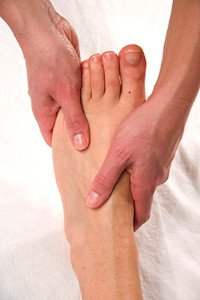 There are several benefits to the overall health of the feet when the toes are properly stretched. Toes may deform gradually over time as a result of several factors. These may include wearing shoes that are too snug for extended periods of time, improper use of the foot muscles while walking, or standing with the feet pointing outward, which puts pressure on the big toe. When the toes are stretched, the possibility of developing Athlete's foot may diminish as a result of adequate space between the toes. There are simple and effective toe stretches that can be performed daily for optimum results. These may include bending your toes downward to stretch the top of the foot, and taking each toe in your hands while pulling it away from the toe next to it. If you would like additional information about the benefits of stretching your toes, please consult with a podiatrist.
There are several benefits to the overall health of the feet when the toes are properly stretched. Toes may deform gradually over time as a result of several factors. These may include wearing shoes that are too snug for extended periods of time, improper use of the foot muscles while walking, or standing with the feet pointing outward, which puts pressure on the big toe. When the toes are stretched, the possibility of developing Athlete's foot may diminish as a result of adequate space between the toes. There are simple and effective toe stretches that can be performed daily for optimum results. These may include bending your toes downward to stretch the top of the foot, and taking each toe in your hands while pulling it away from the toe next to it. If you would like additional information about the benefits of stretching your toes, please consult with a podiatrist.
Stretching the feet is a great way to prevent injuries. If you have any concerns with your feet consult with Dr. Barbara Kilkenny from Barbara A. Kilkenny, DPM. Our doctor will assess your condition and provide you with quality foot and ankle treatment.
Stretching the Feet
Stretching the muscles in the foot is an important part in any physical activity. Feet that are tight can lead to less flexibility and make you more prone to injury. One of the most common forms of foot pain, plantar fasciitis, can be stretched out to help ease the pain. Stretching can not only ease pain from plantar fasciitis but also prevent it as well. However, it is important to see a podiatrist first if stretching is right for you. Podiatrists can also recommend other ways to stretch your feet. Once you know whether stretching is right for you, here are some excellent stretches you can do.
It is best to go easy when first stretching your foot and work your way up. If your foot starts hurting, stop exercising and ice and rest the foot. It is advised to then see a podiatrist for help.
If you have any questions, please feel free to contact our office located in Southbury, CT. We offer the newest diagnostic and treatment technologies for all your foot care needs.
Read more about How to Stretch Your Feet If you have ever experienced a corn on the top of the toes, you most likely are aware of the pain that is associated with it. Corns are generally the result of increased pressure and rubbing, and typically originates from shoes that do not fit correctly. It appears to be a small area, and the skin will be hardened and thick. There are known to be two types of corns and are referred to as hard and soft corns. The latter generally develops in between the toes and are often soft, because of the excess moisture and sweat that is present. Hard corns come from wearing shoes that are too tight and may often cause the toes to endure unwanted pressure, resulting in pain and discomfort. There are different types of treatments that may be used to eliminate corns, and it’s advised to speak with a podiatrist for possible relief options that are correct for you.
If you have ever experienced a corn on the top of the toes, you most likely are aware of the pain that is associated with it. Corns are generally the result of increased pressure and rubbing, and typically originates from shoes that do not fit correctly. It appears to be a small area, and the skin will be hardened and thick. There are known to be two types of corns and are referred to as hard and soft corns. The latter generally develops in between the toes and are often soft, because of the excess moisture and sweat that is present. Hard corns come from wearing shoes that are too tight and may often cause the toes to endure unwanted pressure, resulting in pain and discomfort. There are different types of treatments that may be used to eliminate corns, and it’s advised to speak with a podiatrist for possible relief options that are correct for you.
If you have any concerns regarding your feet and ankles, contact Dr. Barbara Kilkenny of Barbara A. Kilkenny, DPM. Our doctor will treat your foot and ankle needs.
Corns: What Are They? and How Do You Get Rid of Them?
Corns can be described as areas of the skin that have thickened to the point of becoming painful or irritating. They are often layers and layers of the skin that have become dry and rough, and are normally smaller than calluses.
Ways to Prevent Corns
There are many ways to get rid of painful corns such as wearing:
Treating Corns
Treatment of corns involves removing the dead skin that has built up in the specific area of the foot. Consult with Our doctor to determine the best treatment option for your case of corns.
If you have any questions please feel free to contact our office located in Southbury, CT. We offer the newest diagnostic and treatment technologies for all your foot and ankle needs.
Read more about Understanding Corns and Calluses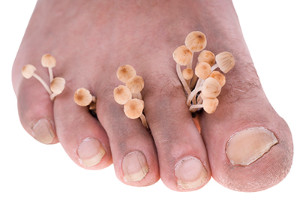 Many people are unaware that they may have toenail fungus, and this may often be a result of a lack of pain and discomfort. Common symptoms that are associated with this ailment may include the toenail becoming dry and brittle, the nail appearing yellow and thick, or a separation from the nail and the nail bed. It’s important to take proper care of your feet, which may possibly avoid this unsightly condition from developing. There are several ways to accomplish this, including wearing shoes that fit properly, trimming the toenails correctly, and wearing appropriate shoes in the shower and pool areas. If you are afflicted with toenail fungus, it’s suggested to speak with a podiatrist who can provide proper guidance for the best treatment options.
Many people are unaware that they may have toenail fungus, and this may often be a result of a lack of pain and discomfort. Common symptoms that are associated with this ailment may include the toenail becoming dry and brittle, the nail appearing yellow and thick, or a separation from the nail and the nail bed. It’s important to take proper care of your feet, which may possibly avoid this unsightly condition from developing. There are several ways to accomplish this, including wearing shoes that fit properly, trimming the toenails correctly, and wearing appropriate shoes in the shower and pool areas. If you are afflicted with toenail fungus, it’s suggested to speak with a podiatrist who can provide proper guidance for the best treatment options.
For more information about treatment, contact Dr. Barbara Kilkenny of Barbara A. Kilkenny, DPM. Our doctor can provide the care you need to keep you pain-free and on your feet.
Toenail Fungus Treatment
Toenail fungus is a condition that affects many people and can be especially hard to get rid of. Fortunately, there are several methods to go about treating and avoiding it.
Antifungals & Deterrence
Oral antifungal medicine has been shown to be effective in many cases. It is important to consult with a podiatrist to determine the proper regiment for you, or potentially explore other options.
Applying foot powder on the feet and shoes helps keep the feet free of moisture and sweat.
Sandals or open toed shoes – Wearing these will allow air movement and help keep feet dry. They also expose your feet to light, which fungus cannot tolerate. Socks with moisture wicking material also help as well.
If you have any questions please feel free to contact our office located in Southbury, CT. We offer the newest diagnostic tools and technology to treat your foot and ankle needs.
Read more about Toenail Fungus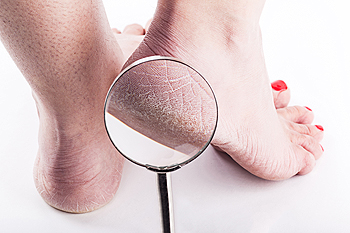 If you stand for extended periods of time you may experience a condition that is referred to as cracked heels. Certain skin conditions that may include psoriasis and eczema may also play a significant role in the development of this condition. The formation of deep cracks, which are also known as fissures, may result in pain and discomfort, and walking may become difficult. The skin on the heels will typically become dry and is usually a result of obesity, wearing shoes that have an open back, and cold winter weather, which may aid in producing dry skin. An effective remedy includes washing and drying the feet thoroughly, followed by utilizing a good moisturizer that will help the skin become soft. It’s advised to consult with a podiatrist if you are afflicted with severely cracked heels, to learn about proper treatment options that are correct for you.
If you stand for extended periods of time you may experience a condition that is referred to as cracked heels. Certain skin conditions that may include psoriasis and eczema may also play a significant role in the development of this condition. The formation of deep cracks, which are also known as fissures, may result in pain and discomfort, and walking may become difficult. The skin on the heels will typically become dry and is usually a result of obesity, wearing shoes that have an open back, and cold winter weather, which may aid in producing dry skin. An effective remedy includes washing and drying the feet thoroughly, followed by utilizing a good moisturizer that will help the skin become soft. It’s advised to consult with a podiatrist if you are afflicted with severely cracked heels, to learn about proper treatment options that are correct for you.
If the skin on your feet starts to crack, you may want to see a podiatrist to find treatment. If you have any concerns, contact Dr. Barbara Kilkenny from Barbara A. Kilkenny, DPM. Our doctor can provide the care you need to keep you pain-free and on your feet.
Cracked Heels
It is important to moisturize your cracked heels in order to prevent pain, bleeding, and infection. The reason cracked heels form is because the skin on the foot is too dry to support the immense pressure placed on them. When the foot expands, the dry skin on the foot begins to split.
Ways to Help Heal Them
Ways to Prevent Cracked Heels
If you are unsure how to proceed in treating cracked heels, seek guidance from a podiatrist. Your doctor will help you with any questions or information you may need.
If you have any questions, please feel free to contact our office located in Southbury, CT. We offer the newest diagnostic and treatment technologies for all your foot care needs.
Read more about Solutions for Cracked Heels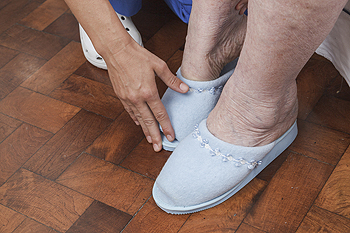 If you are afflicted with arthritic feet, you may find it difficult to perform certain activities, including walking. There is typically a moderate level of inflammation that surrounds the joints of the foot, which may produce considerable pain and discomfort. There are several different forms of arthritis which may affect the feet. If the cartilage begins to decay at the base of the toe, you may have what is referred to as osteoarthritis. This may contribute to other foot conditions such as bunions. Preventive measures may include choosing to wear wider shoes that do not put pressure on the bunion. Additionally, if the joints on the ball of the foot become inflamed, you may have rheumatoid arthritis. This may cause the bone to rub and push against the skin on the sole of the foot, which can often produce severe pain. A possible treatment option that may temporarily provide moderate relief involves attaching a long strip of leather to the bottom of the shoe behind the arch. This may aid in reducing a portion of the pressure that is often associated with this type of arthritis. It’s suggested to consult with a podiatrist to discuss further relief remedies and treatment protocols.
If you are afflicted with arthritic feet, you may find it difficult to perform certain activities, including walking. There is typically a moderate level of inflammation that surrounds the joints of the foot, which may produce considerable pain and discomfort. There are several different forms of arthritis which may affect the feet. If the cartilage begins to decay at the base of the toe, you may have what is referred to as osteoarthritis. This may contribute to other foot conditions such as bunions. Preventive measures may include choosing to wear wider shoes that do not put pressure on the bunion. Additionally, if the joints on the ball of the foot become inflamed, you may have rheumatoid arthritis. This may cause the bone to rub and push against the skin on the sole of the foot, which can often produce severe pain. A possible treatment option that may temporarily provide moderate relief involves attaching a long strip of leather to the bottom of the shoe behind the arch. This may aid in reducing a portion of the pressure that is often associated with this type of arthritis. It’s suggested to consult with a podiatrist to discuss further relief remedies and treatment protocols.
Arthritis can be a difficult condition to live with. If you are seeking treatment, contact Dr. Barbara Kilkenny from Barbara A. Kilkenny, DPM. Our doctor can provide the care you need to keep you pain-free and on your feet.
Arthritic Foot Care
Arthritis is a joint disorder that involves the inflammation of different joints in your body, such as those in your feet. Arthritis is often caused by a degenerative joint disease and causes mild to severe pain in all affected areas. In addition to this, swelling and stiffness in the affected joints can also be a common symptom of arthritis.
In many cases, wearing ill-fitting shoes can worsen the effects and pain of arthritis. Wearing shoes that have a lower heel and extra room can help your feet feel more comfortable. In cases of rheumatoid arthritis, the arch in your foot may become problematic. Buying shoes with proper arch support that contour to your feet can help immensely.
Alleviating Arthritic Pain
It is best to see your doctor for the treatment that is right for your needs and symptoms. Conditions vary, and a podiatrist can help you determine the right method of care for your feet.
If you have any questions, please feel free to contact our office located in Southbury, CT. We offer the newest diagnostic tools and technology to treat your foot and ankle needs.
Read more about Arthritic Foot Care A deformity of the toes that resemble a claw-like shape may be referred to as hammertoe. If the toes do not have adequate room to move about, they may have to bend to fit into the shoe. Additionally, if tight socks are worn, the toes may have to squeeze together, which may cause them to overlap. This condition can produce discomfort and pain, and may possibly cause corns and calluses to develop. Preventive measures may include choosing to wear shoes that fit correctly, while making sure there is ample room in the top of the shoe. Patients who have high arches or bunions may be more susceptible in developing hammertoe, and research has shown that permanent removal of a hammertoe affliction means surgery. It’s suggested to schedule a consultation with a podiatrist who can recommend temporary relief options, which may include custom-made protective pads over the affected area.
A deformity of the toes that resemble a claw-like shape may be referred to as hammertoe. If the toes do not have adequate room to move about, they may have to bend to fit into the shoe. Additionally, if tight socks are worn, the toes may have to squeeze together, which may cause them to overlap. This condition can produce discomfort and pain, and may possibly cause corns and calluses to develop. Preventive measures may include choosing to wear shoes that fit correctly, while making sure there is ample room in the top of the shoe. Patients who have high arches or bunions may be more susceptible in developing hammertoe, and research has shown that permanent removal of a hammertoe affliction means surgery. It’s suggested to schedule a consultation with a podiatrist who can recommend temporary relief options, which may include custom-made protective pads over the affected area.
Hammertoes can be a painful condition to live with. For more information, contact Dr. Barbara Kilkenny of Barbara A. Kilkenny, DPM. Our doctor will answer any of your foot- and ankle-related questions.
Hammertoe
Hammertoe is a foot deformity that occurs due to an imbalance in the muscles, tendons, or ligaments that normally hold the toe straight. It can be caused by the type of shoes you wear, your foot structure, trauma, and certain disease processes.
Symptoms
Risk Factors
Treatment
If you have hammertoe, you should change into a more comfortable shoe that provides enough room for your toes. Exercises such as picking up marbles may strengthen and stretch your toe muscles. Nevertheless, it is important to seek assistance from a podiatrist in order to determine the severity of your hammertoe and see which treatment option will work best for you.
If you have any questions, please feel free to contact our office located in Southbury, CT. We offer the newest diagnostic and treatment technologies for all your foot care needs.
Read more about What Are Hammertoes?